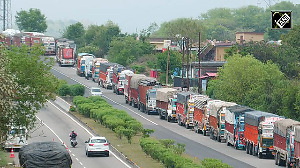With night temperatures dipping to near zero in the remote earthquake-hit areas of Jammu and Kashmir, survivors deprived of proper food and roof over their heads are staring into another grave disaster.
Occasional rains have turned damp whatever firewood they could gather from what remained of their houses, snatching the last straw they could cling on to keep themselves alive.
The lucky few who have got at least a blanket from the administration, are doubtful whether it would see them through the winter, which has already set in.
And the few with tents on their heads also wouldn't be able to ward off the cold as they can't light fires inside.
"We are left in the open to fend for ourselves. I cannot stand the sight of my wife and children shivering in the night. It seems we will all die here in the cold," says Abdul Hameed, resident of Thajal village, 13 kms from Uri town, one of the worst ravaged in the October 8 quake.
Twenty people died in this tiny border village alone in the October 8 killer temblor, but residents say many more would have perished, with the missing figures exceeding 50.
The administration on its part seems to have admitted its inability to provide shelter to these hapless souls, though it repeatedly claims that it has provided temporary shelters to around 40 per cent of the survivors.
"It will take us another 15 days to procure more tents and other material needed for further distribution. However, we have distributed more than 14,000 tents among the estimated 38,000 families," Divisional Commissioner, Kashmir, B B Vyas, who is co-coordinating the entire relief operations in the valley, said.
The residents of the remote villages say they may not be able to survive through the coming week itself, leave alone a fortnight, with the temperatures dipping by the day.
This may lead to another disaster in the Valley-- a disaster due to deprivation.
"Our children cry out in the night, unable to bear the biting cold. We just embrace them tightly and pray to Allah for mercy," Hammed says, his eyes moistened by tears.
"How can we sleep peacefully here? We can still feel the earth underneath us shaking," he says. More than 500 aftershocks have been reported in the quake-hit areas till date, according to official sources.
"We have thought many times to flee this area and go somewhere else. But where shall we go empty-handed? We are yet to receive the compensation for our shattered home," he says.
Squatting beside Hammed, his wife Ruksana and his three children. The kids are eating some rice that Hammed had managed to salvage from his heavily battered home, and cooked in mangled utensils.
Ghulam Mir, another villager, is furious that politicians and top officials have made regular sorties to Uri and nearby areas to hog the limelight. He says these flights could have been better used to bring in the much-needed relief to the remote villages.
"They are bothered only about getting in the news. They just want to show that they are doing something, but the reality is that it is they are doing nothing for poor people like us," Mir says.
In Kamalkote village, where around 260 people died, a couple of tents can be sighted. However, the number of homeless is around three to four times more than what the tents could accommodate.
"We have heard them (officials) claiming that they have provided enough blankets and tents to us. But if that is true, why has it not yet reached our hands?" asks Abdel Yakub.
"Besides, these tents would be of little use in the winter. One strong wind can blow the whole thing away. Then how can it protect us from the heavy snow?" he asks.
"Even though we manage to get some dry firewood, we can't light it up inside the tents as they are made of canvas or tarpaulin that can easily catch fire," Yakub says.
With officials making excuses that the rehabilitation process is a mammoth exercise that will run up to many months together, they are silent about the number of dead bodies that may fall here merely because of the lack of proper shelter.







 © 2025
© 2025